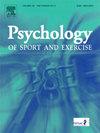小学运动能力与执行功能的关系。
IF 3.3
2区 心理学
Q2 HOSPITALITY, LEISURE, SPORT & TOURISM
引用次数: 0
摘要
运动能力和执行功能(即自上而下的行为控制)由于共享的神经基质而被认为是共同发展的。然而,执行功能的组成部分表现出不同的发展轨迹,因此年龄如何影响这两个领域之间的相互关系尚不清楚。因此,我们在代表不同年级的队列中调查了运动能力和执行功能组成部分之间关联的强度和稳定性。400名瑞士1年级(7岁)至5年级(11岁)的男女学生完成了与年龄相适应的MOBAK测试,以评估运动能力。此外,我们还执行了一个改进的Flanker任务,包括标准和切换块以及N-back任务,以检查抑制控制、任务切换和工作记忆。包括所有参与者在内的路径分析显示,运动能力与执行功能的所有组成部分之间存在低到中度的关联。然而,这种关联的强度和稳定性在不同年级之间存在差异。在所有亚组中,较高的运动能力始终与较好的抑制控制相关,但其与任务转换和工作记忆的关联仅限于特定年级水平。综上所述,运动能力与抑制控制之间的关系在前五个年级具有稳定性,而其可分离成分之间的关系则呈非线性趋势。这表明运动能力干预有可能根据发育时期对执行功能成分产生不同的影响。本文章由计算机程序翻译,如有差异,请以英文原文为准。
The association of motor competence and executive function across primary school years
Motor competence and executive function (i.e., top-down control of behavior) have been suggested to co-develop due to shared neural substrates. However, components of executive function show different developmental trajectories, so that it remains unclear how age affects interrelations between both domains. We therefore investigated the strength and stability of the association between motor competence and components of executive function across cohorts representing different grades. 400 Swiss girls and boys attending grades 1 (7 y) to 5 (11 y) completed age-appropriate versions of the MOBAK test battery to assess motor competence. Additionally, we administered a modified Flanker task including both standard and switching blocks as well as an N-back task to examine inhibitory control, task-switching and working memory. Path-analysis including all participants revealed a low to moderate association between motor competence and all components of executive function. However, the strength and stability of the association differed across grade levels. Higher motor competence was consistently related to better inhibitory control in all subgroups, but its association with task-switching and working memory was limited to specific grade levels. In conclusion, the association between motor competence and inhibitory control is characterized by stability across the first five school grades, whereas the association with its separable components follows a non-linear trend. This provides an indication that motor competence interventions have the potential to influence executive function components differently depending on the developmental period.
求助全文
通过发布文献求助,成功后即可免费获取论文全文。
去求助
来源期刊
CiteScore
6.40
自引率
5.90%
发文量
172
审稿时长
69 days
期刊介绍:
Psychology of Sport and Exercise is an international forum for scholarly reports in the psychology of sport and exercise, broadly defined. The journal is open to the use of diverse methodological approaches. Manuscripts that will be considered for publication will present results from high quality empirical research, systematic reviews, meta-analyses, commentaries concerning already published PSE papers or topics of general interest for PSE readers, protocol papers for trials, and reports of professional practice (which will need to demonstrate academic rigour and go beyond mere description). The CONSORT guidelines consort-statement need to be followed for protocol papers for trials; authors should present a flow diagramme and attach with their cover letter the CONSORT checklist. For meta-analysis, the PRISMA prisma-statement guidelines should be followed; authors should present a flow diagramme and attach with their cover letter the PRISMA checklist. For systematic reviews it is recommended that the PRISMA guidelines are followed, although it is not compulsory. Authors interested in submitting replications of published studies need to contact the Editors-in-Chief before they start their replication. We are not interested in manuscripts that aim to test the psychometric properties of an existing scale from English to another language, unless new validation methods are used which address previously unanswered research questions.

 求助内容:
求助内容: 应助结果提醒方式:
应助结果提醒方式:


